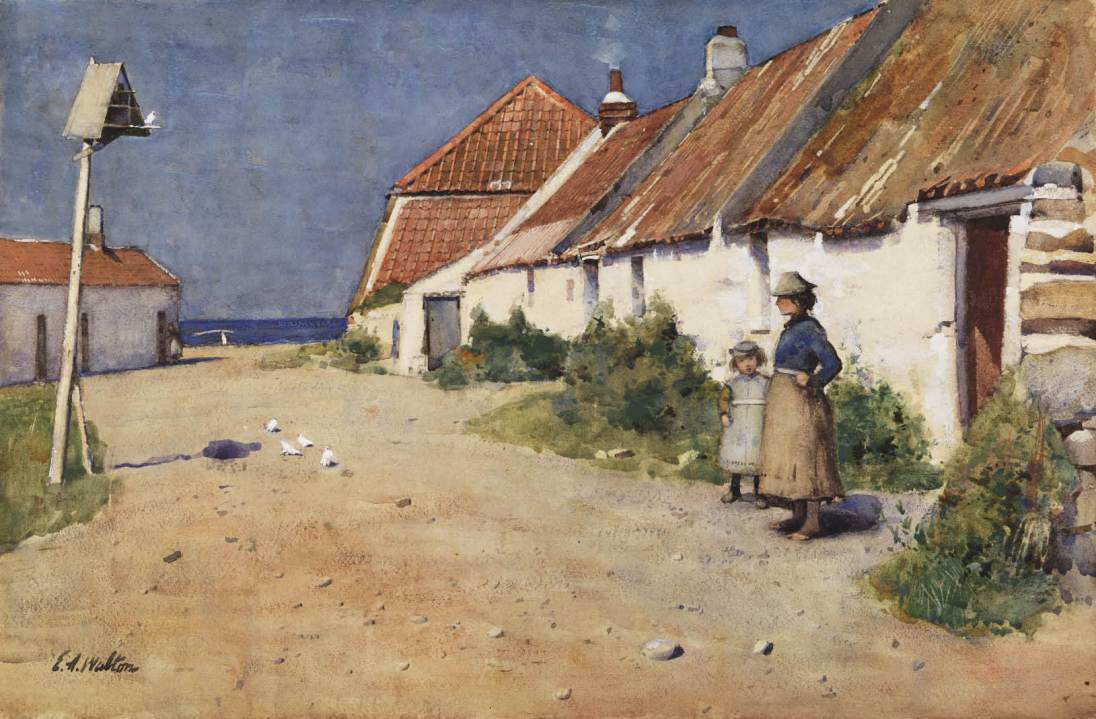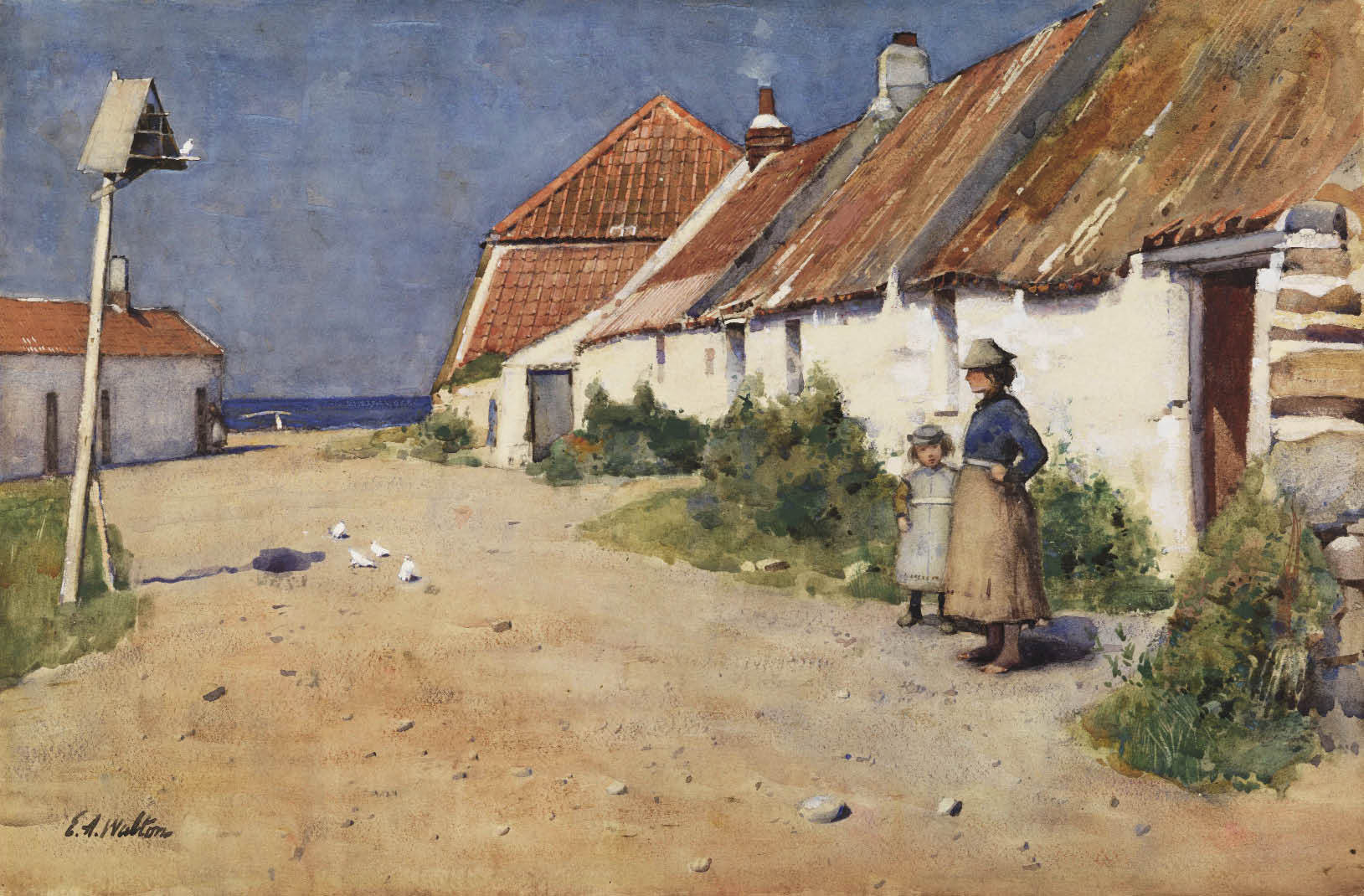The so-called Glasgow Boys had no manifesto, common background or style, apart from working in and around the city of Glasgow and sharing a belief in the importance of painting from direct observation and experience. They acknowledged the influence of the naturalism practised by the Barbizon and Hague schools in the later 19th century, and rejected narrative in painting and especially the sickly sentimentalism that bedevilled so much Victorian art. They were a loosely associated group of painters, sometimes called the Glasgow School but preferring to be known by the slightly more raffish title of the Glasgow Boys, who banded together principally to exhibit. This ploy worked and they achieved a degree of international recognition. But they remained very much a coalition of individuals, each interpreting the new gospel of realism in their own way, though making a speciality of picturesque scenes, leaning in particular towards the depiction of peasant life, itself open to a different kind of sentimentality.
Their vigorous brushwork and heightened naturalistic colour made them forerunners of the better-known and more decorative Scottish Colourists, but in spirit they are remote from the flashy modernism of the latter. There is an earnestness to the Glasgow Boys which makes them harder to look at, however worthwhile and competent their brushwork and painterly values. It is difficult now for us to appreciate how revolutionary their light-filled canvases looked after a diet of the dark and predictable narrative paintings which were then so fashionable. To the early 21st-century eye, the RA show does not pulse with visual excitement: peasants and domesticated animals in an ambience of greenery suggest dull labour rather than inspiration. However skilful an artist such as William Stott of Oldham is, you have to be in a slightly melancholy and wistful mood to appreciate a painting like ‘The Ferry’ (c.1882).
But in the first room of the exhibition there is a lovely fresh little study by James Guthrie called ‘Hard at It’, an informal scene of an artist painting in the shade of a beach umbrella, which is full of light and the excitement of vibrantly applied paint. This is observational painting at its unpretentious best. Figures in cabbage fields do not beguile me, nor girls driving geese, however finely painted. It’s not the subject that repels so much as the genteel treatment; simply not gutsy enough. I prefer the straight landscapes to the figures in slightly self-conscious rural settings. There are cabbages in ‘A Cottage Garden, Crail’ by William Macgregor, but the blue-green of the vegetables is nicely offset by the pinky-red of the roofs. Much better.
Particularly impressive is ‘Autumn in Glencairn’ (1887) by James Paterson, in which there’s a marvellous sense of distance and a beautiful central passage of light reflected off water, plus the pale light on the far hills. Next to it is a very different kind of painting — blurry, feathery and atmospheric — Thomas Dow’s ‘Hudson Rover’, just to indicate the breadth of approach on show. The section given over to the artists’ colony of Grez-sur-Loing includes some very fine paintings by John Lavery, probably my favourite of the Glasgow Boys because of his inventiveness with paint and intensity of design. Look at the layout of colours in ‘Sewing in the Shade’, rather than the girls’ cheeky expressions. Also ‘The Hammock, Twilight’ — I can’t help thinking both would be better paintings without the people.
Opposite there’s a really lovely unassuming little painting, George Henry’s ‘Sundown’, with an endearing sizzle of light reflected on water. In the penultimate room, Arthur Melville comes into his own, principally through the remarkable control and rich luscious hues of watercolours such as ‘Brig o’ Turk’ and ‘The Little Bullfight’. From a distance his painting ‘The Sapphire Sea’ looks like an oil, but study it closely and marvel at its watercolour technique. The show ends well with a fine pair of portraits: Cunninghame Graham by Lavery and Lady Finlay by Guthrie. There’s also an attractive Edward Atkinson Hornel, called ‘The Goatherd’, and a lively semi-abstract arrangement of blues, creams and apricots by Melville entitled ‘The Contrabandista’.
Meanwhile, at The Fleming Collection, 13 Berkeley Street, W1 (until 18 December) is another Glasgow Boys’ exhibition. There are some good things, including ‘Crowland Bridge’ by Guthrie, built up from squares and rectangles of paint, with a judicious use of orange and blue, and next to it Paterson’s ‘Winter Sunshine, Moniaive’, all blue and tawny gold. The best painting is Lavery’s deliciously understated ‘Bridge at Hesterworth, Shropshire’ (1884), mysterious and alive in all its parts. The second-wave Glasgow Boy David Gauld I liked less, his paintings having a chalky and slightly soft-focus quality, though his trenchant pencil drawings somewhat make up for that. Downstairs, an interesting-looking watercolour by Joseph Crawhall, ‘Pigeons in a Cage’, is horribly compromised by bad lighting. This picture deserves to be compared closely to James Paterson’s wintry landscape nearby, for their similarity of vertical structuring. There are some rather awful pictures here too (for instance, by William Kennedy and Edward Walton) so Charles Rennie Mackintosh’s watercolour of a butterfly flower comes like a draught of spring water after too much fudge.
A selling exhibition of 1,000 drawings by a contemporary artist, Colin Self, couldn’t offer more of a contrast. Self (born 1941) is usually pigeonholed as a Pop artist, but his extraordinary range of imagery and interest can be seen here, perhaps for the first time. There have been museum shows of his work (most recently at Pallant House in Chichester in 2008), but nothing with quite this breadth. The show is particularly appropriate because Self is primarily a draughtsman, witty, ingenious and inventive, who gives structure to his thoughts first through drawing. ‘Drawing’ should be loosely interpreted in this context, as Self is an inspired collagist and draws with found and cut-out shapes as much as he does with pencil or pen.
This audacious exhibition features unseen work made over the past 50 years and includes trademark Self images such as clowns, sofas and hotdogs. In fact, there’s a whole wall of hamburgers and hotdogs, in cut-out and painted card, seductive with ketchup and mustard. There’s another wall of pet rabbits in hutches. The gallery is actually one vast collage of drawings pinned to the walls — not quite 1,000, they wouldn’t all fit, but a magnificent sampling of this brilliant and highly original artist. Richard Hamilton is on record as saying that Self is ‘the best draughtsman in England since William Blake’, and this is an incomparable chance to acquire a unique example of his work.







Comments